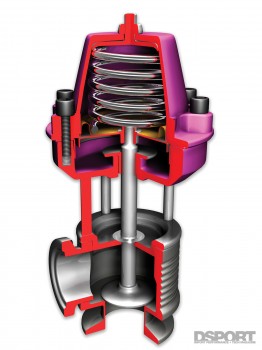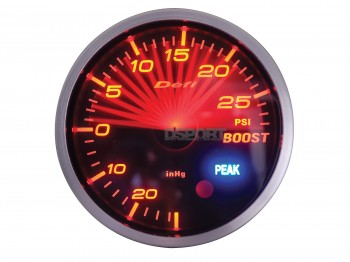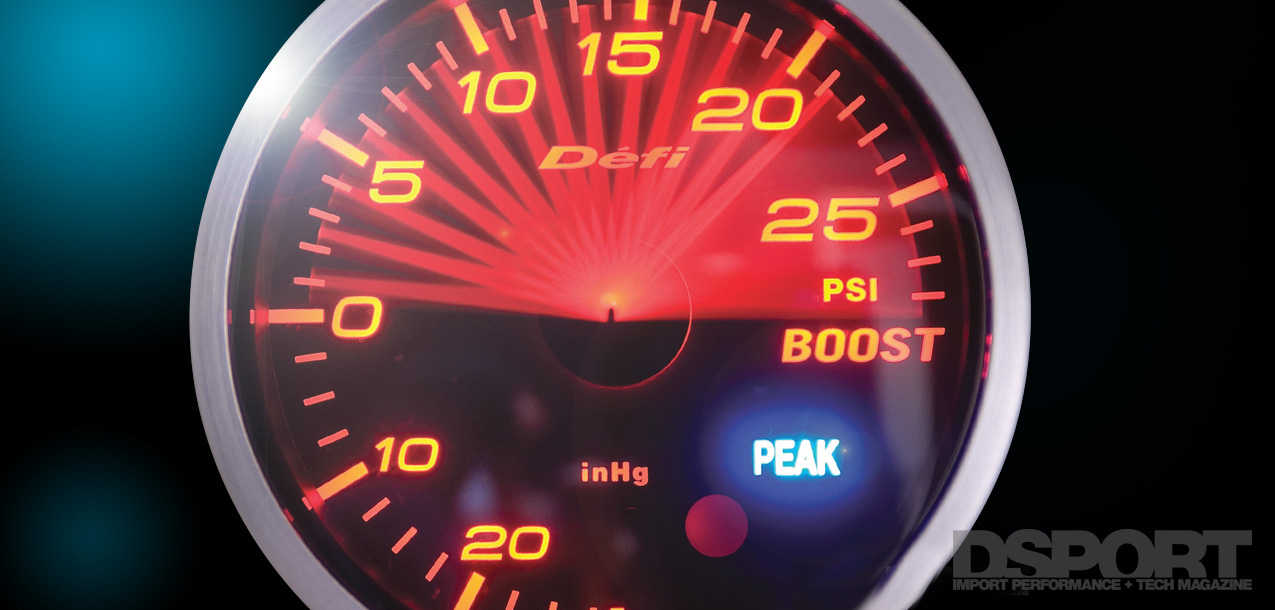 Boost Mode
Boost Mode
On a two- or three-port solenoid, the pressure difference between the top and bottom port is equalized when the solenoid is controlled to allow maximum boost output. A two-port solenoid will send no pressure to both ports when set into a boost -production mode. This generates a pressure differential of zero.
On a three-port solenoid, the pressure differential is also zero. However, a three-port solenoid will send equal boost pressure to the top and bottom port, but in either case, this means that no lifting or closing force is applied to generate valve movement in the wastegate. Instead, the wastegate stays closed until the exhaust backpressure reaches a level high enough to overcome the preloaded valve-seat pressure. In most cases, this happens at a point that is about double the rated pressure of the actuator or wastegate.
Positive Top
When a four-port solenoid is used with a dual-port wastegate, a unique condition can be achieved where a positive pressure differential, acting on the top of the diaphragm, aids to keep the wastegate closed until a higher boost pressure. This is how a four-port solenoid/dual-port wastegate combination can deliver boost pressures that may be up to six times the rated pressure of the wastegate.
Boost Pressure Ratings
 Wastegate actuators (used on internal wastegate turbochargers) are rated to deliver a specific boost pressure. Aftermarket performance wastegate actuators can offer three advantages over the stock actuator. First, they will generally be rated at a higher boost pressure. While a stock actuator may set the minimum boost pressure to 10 psi, an aftermarket unit may set it at 15 psi. When selecting an aftermarket actuator, choose one rated to deliver the minimum boost pressure that your setup desires. Unless a dual-port actuator is teamed with a four-port solenoid, you shouldn’t expect to see maximum achievable boost pressures more than double the spring pressure. Hence, a 15 psi actuator will never allow for boost to be lower than 15 psi or higher than 30 psi in most applications.
Wastegate actuators (used on internal wastegate turbochargers) are rated to deliver a specific boost pressure. Aftermarket performance wastegate actuators can offer three advantages over the stock actuator. First, they will generally be rated at a higher boost pressure. While a stock actuator may set the minimum boost pressure to 10 psi, an aftermarket unit may set it at 15 psi. When selecting an aftermarket actuator, choose one rated to deliver the minimum boost pressure that your setup desires. Unless a dual-port actuator is teamed with a four-port solenoid, you shouldn’t expect to see maximum achievable boost pressures more than double the spring pressure. Hence, a 15 psi actuator will never allow for boost to be lower than 15 psi or higher than 30 psi in most applications.
Second, aftermarket wastegate actuators may use a dual-port instead of single-port design. Adding this second port to the actuator allows for the opportunity to have better control of the wastegate to optimize the boost curve. Using a three- or four-port solenoid with a dual-port actuator is essential to making the most out of a the dual-port actuator.
Third, an aftermarket wastegate actuator may also provide a control rod that allows for the preload on the flapper valve to be adjusted. Being able to make this mechanical adjustment allows for an increase in the lowest boost pressure generated, improved boost response and limit to the boost drop at higher rpms with “small” turbos.
Nearly all external wastegates feature dual ports and an assortment of available springs to deliver a specific base boost pressure. Some may also incorporate a spring preload adjustment. The dual ports and preload adjustment on external wastegates allow for the same benefits mentioned with regard to dual-port actuators. The wide variety of interchangeable springs allows for the base boost pressure rating to be adjusted simply by changing the spring.


